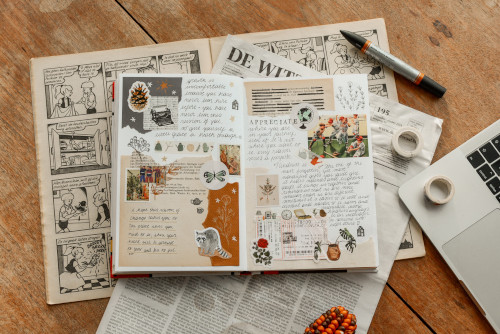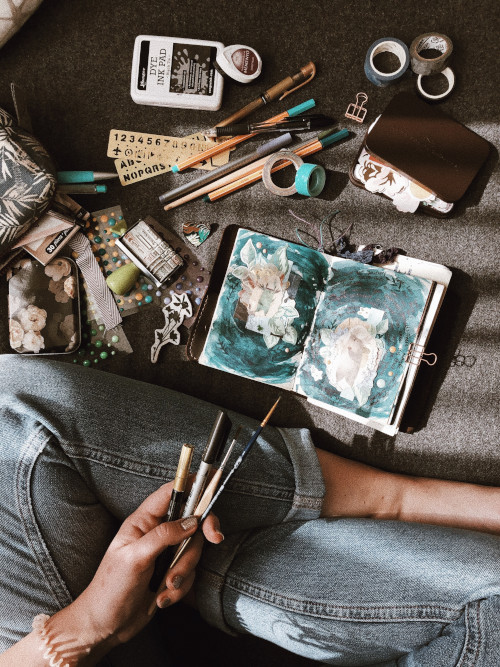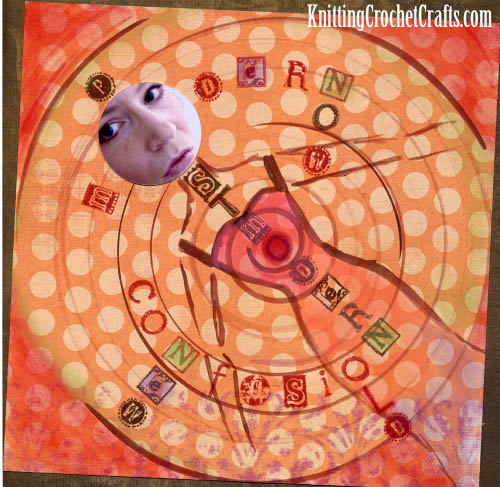
Art journaling: What is it? And how do you do it? What are the differences between art journaling and regular, ordinary journaling? Is art journaling basically the same thing as scrapbooking? And how is art journaling different from bullet journaling — are they the same thing? Let’s take a look at the factors that differentiate art journaling from other similar art forms.

Art Journaling vs Ordinary Journaling
Journaling is a process of taking a writing instrument to paper, or fingers to keyboard, to write down your thoughts.
The art journaling process is largely the same, but with artwork added. The art could be drawing, painting, illustration, collage art, photography, calligraphy, hand lettering or some other kind of art — but the art and the journaling elements are both typically present in an art journal. It’s up to the art journaler to decide whether one or the other type of element will be more prominent.

I suppose it could also be possible to have an art journal that doesn’t include any journaling — although, personally, I would prefer to refer to that type of thing as a “sketch book”, or perhaps a “photo essay”, depending on the type of art it incorporates.
Art Journaling vs Scrapbooking
Do You Think The Following Pages Are Scrapbook Pages, or Art Journal Pages?

Answer: I’m Not Sure, Either.
Perhaps you’re wondering: Is there a difference between art journaling and scrapbooking?
I’ve pondered this question at length, because I do both art journaling and scrapbooking.
I think the line between the two is totally blurry. I think it would be possible to find examples where there is essentially no difference between an art journal and a scrapbook.
BUT!
In my own work, most of the time, there is a clear and compelling difference between the two (but not always. The pages above are examples of pages that could go either way; I could put them in either my art journal or my scrapbook).
The books that I refer to as “scrapbooks”, I’ve put the emphasis on featuring photos of my life — mostly pictures of everyday moments and trips taken with my sweetheart or my friends. The pages also have dates, page titles (sometimes) and journaling which is usually about the specific event pictured.
My art journals are far more abstract.
Usually, there are no photos to go along with the writing. Instead, there is artwork that goes along with the writing. The artwork is probably completely unrelated to the writing on the page — it’s probably random collaged bits of spin art or paper lace or punch art. The thoughts on the page might also be completely random insights — or they might be things I wanted to remember about my experiences that day.
But, honestly, my scrapbook pages also contain bunches of the same elements — things like spin art bits and paper lace borders. the scrapbooks and art journals could be merged, and it would work fine. The distinction between the two types of pages is not really so distinct that anyone would think twice about seeing the two types of pages presented together in the same book.
So, main takeaway: In general, a scrapbook is where the main focus is on the photos. An art journal is where the main focus is on the art. But, since you could create one book where the focus flip-flops between photos and art, in that case, it would be a challenge to definitively give that particular book a label of either scrapbook or art journal. You could call it by either name. So, bottom line, if you were to insist that scrapbooking and art journaling are the same thing, I wouldn’t find it worth the time to argue with you.
Bullet Journaling vs Art Journaling
If you’ve seen some of the artistic bullet journals people are creating, you might wonder what’s the difference between an art journal and a bullet journal. In theory, there is actually a distinct difference. But, in practice, since you can create either a bullet journal or an art journal exactly as you please, you can choose to ignore the practical differences to create either type of journal the way you want to.
Bullet journaling was popularized by Ryder Carroll. My understanding of the situation is that his intention was to create a system that increased and enhanced productivity. Essentially, his bullet journal methods consolidate a routine task list, calendar and a journal into one item.
I think this is pure genius!
The best thing about it is that you can make your bullet journal as artistic or as utilitarian as you like — whichever way suits your personal style.
I haven’t quite managed to transition myself to the bullet journaling method yet, but that’s only because I’m so heavily invested in my old, separate planner, journals and art journals. After I’ve used up the supplies I already have, I do plan to transition to what I think is his far superior method of organizing journal output.
Update: I originally wrote this article on 7-15-2019. It is now 10-23-2021, and since I originally wrote this piece, I have discovered discbound planner systems. Discbound planners are a HUGE game changer for me. I LOVE the idea of bullet journaling, and I am now incorporating many ideas borrowed from bullet journaling into my own planners, art journals and regular journals. However, now that I have discovered discbound planners, I am unlikely to ever use ordinary notebooks again. If discbound planners are of interest to you, I invite you to learn more about them in our pages on planners, calendars, journals and organizers.
How to Make an Art Journal
There is no set-in-stone, absolutely definitive method of making an art journal. My instructions would basically be — get some sort of notebook, journal or book that has pages in it, or that has the capacity to have pages added to it and taken out of it. If you want to keep the book for a long time, make sure the pages are acid free and archival quality.
Get some sort of art and craft supplies like pens, pencils, markers and / or paints. If you plan to collage in the book, you’ll also need an adhesive. Draw, paint, collage in the book. Stick photos or other memorobilia into it if you like. Write your thoughts in it.
Include the date, because, 20 years from now, you won’t remember what day or year you were writing about unless you include that information.
And, when you write, be as specific as possible. I give this advice because looking back at my own old journals, the writing is often so vague that I sometimes have no idea what I was talking about. I’m giving you the above advice in hopes of saving you from that particular mistake. It’s one that I have deep regrets about making often in my own journals.
When you write about your loved ones, try to include specific quotes of the things that they said. This is hard — but if you work at it, you will get better at remembering specific quotes.
For example:
Don’t Write This: I was so proud and excited when Mom told me what she thinks about my report card.
Instead, Write This: When Mom opened my report card today, she said, “I can see you’ve made some big improvements in math and science this semester. All your studying has paid off. Great job!” Her comment made me feel so proud and excited.
20 years from now, you will most likely not remember what your report card looked like, and you also will not remember what your mom said about it. So if you want to have any hope of remembering those things in the future, your best shot at that is to write down the essentials when they are still fresh in your mind.
When you’re young, your memory is better than it will become later as you age. You have NO IDEA how much stuff you will forget in time. Trust me — you will forget a lot. This is hard to comprehend when you are young. You take it for granted that your memory will always be like it is now — but, it probably won’t.
Main takeaway: Journal about the stuff you will want to remember in the future. Don’t bother with journaling about the stuff you won’t care about — petty fights with your family, a mean comment someone made to you, none of that is worth the effort in writing it down. If you won’t care about it in 20 years, don’t bother writing about it now.
If you haven’t already bought supplies for your art journal, I also recommend checking out the product lines being made available by brands like Happy Planner, Martha Stewart, TUL and Arc. Happy Planner, in particular, makes discbound guided journals, memory books, notebooks and planners available that would all be ideal for art journaling. I am transitioning to using discbound planners for all my planning, journaling and memory keeping (which, honestly, will blur the line even further between my art journals and scrapbooks — and that is totally OK, because in hindsight, it doesn’t really make much sense to keep them separate.)
So there you have it: Those are my thoughts on the basic essentials of art journaling. I hope you find these insights helpful as you decide whether this is something you want to pursue — and if you do, how to go about it.
Happy journaling!
Posted By: Amy Solovay
This page was last updated on 7-5-2023.